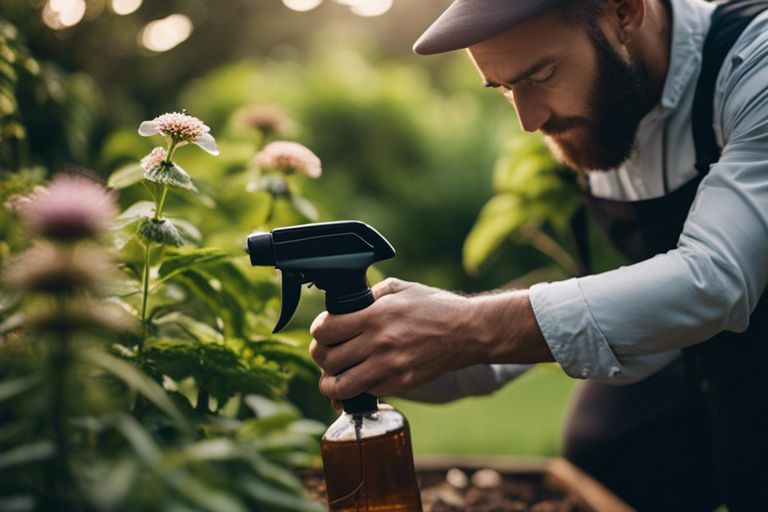You may have noticed unwelcome visitors munching on your prized plants in the garden. Caterpillars can be a nuisance, damaging your garden and hindering the growth of your plants. In this blog post, we will explore effective methods to get rid of caterpillars in your garden and protect your greens from further harm. By following these strategies, you can ensure a healthy and thriving garden free from these pesky pests.
Key Takeaways:
- Handpick caterpillars: Regularly inspect your plants and physically remove caterpillars by hand. This can be an effective way to control caterpillar populations in your garden.
- Use natural predators: Introduce beneficial insects like ladybugs, lacewings, or parasitic wasps that prey on caterpillars. This can help keep caterpillar numbers in check without the use of chemicals.
- Organic sprays: Consider using organic or natural insecticides like neem oil, bacillus thuringiensis (Bt), or spinosad to control caterpillars in your garden. These options are safer for beneficial insects and the environment compared to chemical pesticides.


Identifying Caterpillars and Their Impact
There’s no denying that caterpillars can wreak havoc on your garden if left unchecked. Recognizing the different types of caterpillars is crucial in determining the best course of action to take.
Recognizing Different Types of Caterpillars
Here are some common caterpillars you might encounter in your garden:
| Armyworms | Green color with a prominent stripe along the side |
| Cabbage Loopers | Pale green caterpillars with white stripes |
| Corn Earworms | Yellow-green caterpillars with dark spots |
| Tomato Hornworms | Large, bright green caterpillars with horn-like structures |
| Codling Moth Caterpillars | Pale caterpillars with brown heads found in apple and pear trees |
Though the appearance may vary, they all share a common goal of devouring your plants. It’s important to identify them accurately to choose the most effective control methods.
Assessing the Damage Caused by Caterpillars
One of the most obvious signs of caterpillar infestation is chewed leaves or fruits on your plants. Plus, caterpillars can stunt plant growth and even cause death if left unchecked. Regularly inspecting your garden for any signs of caterpillar damage is key to preventing extensive harm to your plants. Be mindful of, early detection is key to minimizing the impact on your garden.
Natural and Organic Control Methods
Encouraging Natural Predators
Natural control methods can be highly effective in managing caterpillar populations in your garden. By promoting a healthy ecosystem, you can invite beneficial insects such as ladybugs, lacewings, and parasitic wasps that feed on caterpillars. Planting a diverse range of flowers and herbs can attract these predators and help keep caterpillars in check. Avoid using broad-spectrum insecticides that harm beneficial insects and disrupt the natural balance of your garden.
Home Remedies and Organic Sprays
With the increasing interest in organic gardening, many home remedies and organic sprays have been found to be effective in controlling caterpillars. Ingredients like neem oil, garlic spray, and Bacillus thuringiensis (BT) can be used to repel or kill caterpillars without harming beneficial insects or pollinators. These natural solutions offer a safer alternative to chemical pesticides and can help protect your garden from caterpillar damage.
The use of home remedies and organic sprays is a popular choice for gardeners looking to control caterpillar infestations without resorting to harsh chemicals. Neem oil, derived from the neem tree, has insecticidal properties that can disrupt the growth and development of caterpillars. Garlic spray is another effective remedy that repels caterpillars due to its strong odor. Bacillus thuringiensis (BT) is a naturally occurring soil bacterium that produces proteins toxic to caterpillars when ingested, making it a targeted and eco-friendly option for caterpillar control.

Chemical Controls and Pesticides
Selecting Appropriate Chemical Solutions
Pesticides are a common option for controlling caterpillars in the garden. When selecting a pesticide, it is crucial to choose one that is specifically labeled for caterpillar control. Look for products that contain active ingredients such as Bacillus thuringiensis (Bt) or spinosad, as they are effective against caterpillars while being less harmful to beneficial insects.
Safety Measures and Application Techniques
Chemical pesticides should be handled with extreme care to protect yourself, others, and the environment. Always follow the manufacturer’s instructions regarding dosage, application frequency, and safety precautions. Wear appropriate protective gear such as gloves, goggles, and a mask during the application of pesticides to avoid direct contact. Additionally, apply pesticides during calm weather to prevent drift and only target the specific areas where caterpillars are present.
Understanding the proper safety measures and application techniques for chemical controls is crucial in effectively managing caterpillar infestations in the garden. By following these guidelines, you can safely and efficiently rid your garden of caterpillars while protecting the overall ecosystem.
Preventative Measures and Garden Maintenance
Cultural Practices to Discourage Caterpillar Infestations
With proper cultural practices, you can create an environment in your garden that is less attractive to caterpillars. This includes promoting biodiversity by planting a variety of plants, avoiding the use of chemical pesticides that can harm beneficial insects, and practicing crop rotation to reduce the buildup of caterpillar populations in the soil.
Regular Monitoring and Early Detection Strategies
Infestations can quickly spiral out of control if not detected early. Regular monitoring involves inspecting your plants for signs of caterpillar damage, such as holes in leaves or droppings. Early detection allows you to take immediate action before the infestation spreads throughout your garden.
Measures such as placing pheromone traps or using sticky barriers can help capture adult moths before they lay eggs, reducing the chances of caterpillar infestations. Additionally, handpicking caterpillars off plants and disposing of them can be an effective control method when done consistently.
Final Words
Presently, getting rid of caterpillars in your garden can be achieved through various natural and chemical methods. By promoting biodiversity, using physical barriers, applying organic sprays like neem oil or BT, and even introducing natural predators like birds or beneficial insects, you can effectively manage caterpillar populations without causing harm to your plants or the environment. Remember to regularly inspect your plants for signs of infestation and take timely action to protect your garden from these voracious pests. With a proactive approach and a combination of strategies, you can ensure a healthy and thriving garden free from caterpillar damage.
FAQ
Q: What are caterpillars and why are they harmful to the garden?
A: Caterpillars are the larval stage of moths and butterflies. While some caterpillars are harmless, others can be detrimental to your garden as they feed on leaves, flowers, and fruits, causing damage to plants.
Q: How can I identify caterpillars in my garden?
A: Caterpillars vary in appearance depending on the species, but most have a soft body with multiple segments, six true legs, and additional prolegs. They also come in different colors and patterns.
Q: What are some natural ways to get rid of caterpillars in the garden?
A: You can introduce natural predators like birds, wasps, or praying mantises to control caterpillar populations. Additionally, planting companion plants that repel caterpillars, such as marigolds or lavender, can help deter them.
Q: Are there chemical insecticides that can effectively eliminate caterpillars?
A: Yes, there are chemical insecticides available that can target caterpillars in the garden. However, it is important to use them sparingly and follow the instructions carefully to minimize harm to beneficial insects and the environment.
Q: How can I prevent caterpillars from infesting my garden in the future?
A: To prevent caterpillars from infesting your garden, practice good garden hygiene by removing plant debris and weeds regularly. Inspect your plants frequently for signs of caterpillar damage and take prompt action to prevent their numbers from escalating. Additionally, you can use row covers to physically block caterpillars from laying eggs on your plants.
